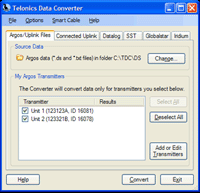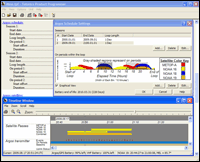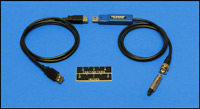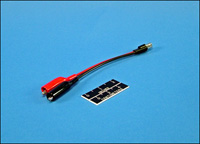GPS/Iridium -3 Terrestrial Systems
The information below on discontinued products is provided for individuals who are still using these older systems. Product descriptions may be time sensitive or even outdated. Please contact Telonics if you have questions.
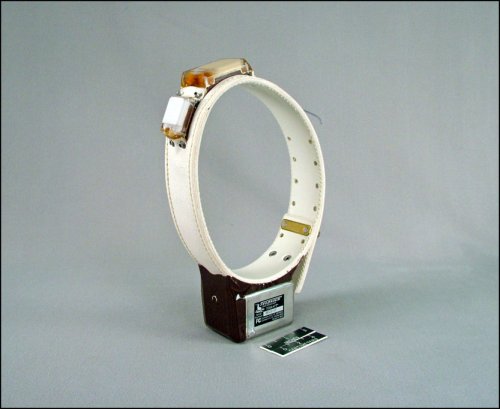
TGW-4570-3 GPS/Iridium collar system on a 1/16th butyl over 1/8th butyl collar with a CAST-2 option designed for ungulates
Key Features
General Features
- The system can be programmed to store high accuracy standard GPS and/or QFP-GPS positions in memory. QFP-GPS is Telonics' new rapid fix GPS technology that obtains the data necessary to calculate a GPS positions in as little as 3-5 seconds. QFP-GPS technology has been used in marine applications for several years and is now making its way into terrestrial applications. The technology can be used to increase the number of positions collected or extend the time over which positions are collected by as much as 3-6 times relative to standard GPS positioning. Location accuracy for GPS/QFP-GPS is virtually the same as standard GPS.
- Other biologically significant data that can be collected include activity level, temperature, and mortality events. For some marine mammal applications (e.g., polar bears) a saltwater switch can provide information on time spent in and out of sea water.
- Real-time clock calendar (RTC) controls all timing functions and is re-synchronized with GPS time to assure high accuracy event timing.
- All products can be programmed by Telonics Product Programmer (TPP) which uses a graphical user interface. TPP makes it possible for users to program their own systems and simulate performance of the system prior to deployment.
- On-board sensors can be activated or deactivated in the field. Data collection regimes and schedules can be altered as required. Collected sensor data can be selectively included in Iridium uplink transmissions.
- Data Decoding - Data are processed using the Telonics Data Converter (TDC), which supports both the Iridium data collection distribution and the direct download of memory using the TSC-4, TSC-7 or TSC-9A cable. TDC provides a comma separated value (csv) output file with time stamps for all data collected, along with a map location for use in Google Earth. TDC can be run interactively, or in "batch mode" for hands-off operation. TDC allows you to plot GPS fixes and QFP-GPS locations for presentation using Google Earth.
- Shutdown with a small magnet allows users to turn each of these configurations "on" or "off". When turned "off", TGW-4xxx series based units consume less than 12 µA. Given these low current levels, users can store their units for extended periods with minimal impact on operational life.
- Units can be refurbished to their original condition at the factory.
Iridium Data Transfer System Features
- Complete global coverage with 66 satellites in the constellation orbiting at 780 km above the earth. Upgrades to these satellites will take place starting in late 2015, continuing through 2017.
- Intra-satellite communication means that signals do not rely on ground stations being in-view to transfer data and the system has true worldwide coverage.
- Two-way communications allows for confirmation of received transmissions, so the system does not need to resend data over and over again.
- The system is always available for real time data transfer.
- Models with support for geofencing and auxillary schedules are available.
Models
Systems with Geofencing and Auxillary Schedules
| Configuration |
Separate VHF Battery |
Dimensions L x W x H
(in, cm) |
Canister Weight (g) |
Estimated Weight with Collar (g) |
Operational life - 1 Year |
Monthly Service Fee |
Operational Life - 2 Years |
Monthly Service Fee |
| Standard |
50% Larger |
| TGW-4577-3 |
|
|
2.9 x 2.3 x 2.0
7.4 x 5.8 x 5.1 |
340 |
700-1100 |
55 min fix interval with daily data uplinks |
~$13.50 per month |
3 hour fix interval with daily data uplinks |
~$10.00 per month |
| TGW-4577B-3 |
X |
|
| TGW-4578-3 |
|
|
2.9 x 2.3 x 2.0
7.4 x 5.8 x 5.1 |
340 |
700-1100 |
55 min fix interval with daily data uplinks |
~$13.50 per month |
3 hour fix interval with daily data uplinks |
~$10.00 per month |
| TGW-4578B-3 |
X |
|
| TGW-4677-3 |
|
|
3.25 x 2.75 x 2.25
8.3 x 7.0 x 5.7 |
625 |
1100-1200 |
20 min fix interval with daily data uplinks |
~$16.00 per month |
50 min fix interval with daily data uplinks |
~$13.50 per month |
| TGW-4677B-3 |
|
X |
| TGW-4678-3 |
|
|
3.25 x 2.75 x 2.25
8.3 x 7.0 x 5.7 |
625 |
1100-1200 |
20 min fix interval with daily data uplinks |
~$16.00 per month |
50 min fix interval with daily data uplinks |
~$13.50 per month |
| TGW-4678B-3 |
|
X |
** TGW-4578-3 and TGW-4678-3 contain a Salt Water Switch
Systems without Geofencing and Auxillary Schedules
| Configuration |
Separate VHF Battery |
Dimensions L x W x H
(in, cm) |
Canister Weight (g) |
Estimated Weight with Collar (g) |
Operational life - 1 Year |
Monthly Service Fee |
Operational Life - 2 Years |
Monthly Service Fee |
| Standard |
50% Larger |
| TGW-4570-3 |
|
|
2.9 x 2.3 x 2.0
7.4 x 5.8 x 5.1 |
340 |
700-1100 |
55 min fix interval with daily data uplinks |
~$13.50 per month |
3 hour fix interval with daily data uplinks |
~$10.00 per month |
| TGW-4570B-3 |
X |
|
| TGW-4670-3 |
|
|
3.25 x 2.75 x 2.25
8.3 x 7.0 x 5.7 |
625 |
1100-1200 |
20 min fix interval with daily data uplinks |
~$16.00 per month |
50 min fix interval with daily data uplinks |
~$13.50 per month |
| TGW-4670B-3 |
|
X |
Operational life estimates for all models shown above are examples calculated by TPP using the following parameters: average environmental temperature of 25°C, expected average time to fix of 75
seconds, successful GPS fix pulse period of 1500 ms, and unsuccessful GPS fix pulse period of 1000 ms. GPS/Iridium systems can be configured to meet most study requirements. Please contact Telonics for details.
There is also a one time $40.00 activation fee per transmitter.
Controlling Data Acquisition and Transmission Using Geofencing
A geofence can be described as a virtual boundary around a physical geographical space, defined by a set of coordinates surrounding an area. Geofences may be established and maintained by a range of GPS-enabled devices including smartphones and devices designed for commercial applications like trucking and farming. Geofencing has also proven to be a useful tool for many animal tracking studies.
Although different animal telemetry manufacturers implement geofencing features in different ways, there are basic similarities in that geofencing is a mechanism that allows one or more geographical areas to be defined and provides customized data acquisition and transmission behavior based on whether the study subject is in "inside" or "outside" the geofence(s). A study subject is considered "inside" when inside any defined geofence, and is considered "outside" when outside all defined geofences.
Note that the speed of detecting that an animal has crossed a boundary and is now in or out of a geofenced area will depend on how much time has elapsed between crossing the boundary and acquisition of the next GPS position. Therefore the rate at which fix attempts are scheduled directly influences the time it will take the unit to detect boundary transitions. Also note that since QFP-GPS data do not provide a resolved position until post processing has occurred, acquisition of QFP-GPS data cannot contribute to the detection of boundary transitions.
- Telonics GPS/Iridium systems can support many geofenced areas, which may overlap. Multiple geofence types are available to establish area(s) of special interest:
- Rectangle - upper left and lower right coordinates are specified.
- Circle - center point and radius are specified.
- Polygon - Up to 50 points may be specified. Polygons may be concave or convex, and may be "closed" (last point and first point are the same), or "open" (first point and last point are not the same).
- Separate Inside and Outside schedule sets are provided to control:
- Acquisition for QFP-GPS, GPS, underwater, activity, and temperature data
- VHF Beacon transmissions
- Iridium transmission behavior specified by date range: transmission interval, transmission retry delay, and message expiration
Controlling Data Acquisition and Transmission Using Auxiliary Schedule Sets
Iridium SBD (Short Burst Data service) is a two-way messaging system. Information can be recovered from and also sent to an Iridium system deployed in the field. The simplest use of the two-way capability is the acknowledgement of message data received from a system in the field to assure that the deployed system can stop sending old data and proceed to send newer data. In more sophisticated Iridium systems, other messages can be sent to the deployed unit. Telonics GPS/Iridium systems take advantage of the two-way communications to alter the behavior of the system in the field, as specified by the researcher.
Auxiliary schedules are created in TPP. TPP can then send email to Iridium to instruct the deployed unit to switch schedules. The unit will then switch schedule sets the next time it connects to the Iridium network, which typically happens on a daily basis. In addition to the default schedule set, which controls all data acquisition and transmit behaviors. Auxiliary schedule sets are useful for increasing or decreasing the intensity of data collection and/or data transmission. Auxiliary schedule sets are also useful for adjusting the VHF beacon duty cycle to save energy when there are no plans to be out in the field monitoring units with a VHF receiver.
- Auxiliary schedules provide the capability to control:
- Acquisition of QFP-GPS, GPS, underwater, activity, and temperature data
- VHF Beacon transmissions
- Iridium transmission behavior specified by date range: transmission interval, transmission retry delay, and message expiration
- GPS/Iridium systems can be directed to execute an Auxiliary schedule (or return to the default schedule) by sending commands over the Iridium data link.
- Commands to GPS/Iridium systems are sent via email using TPP. Internet connectivity and an email provider are required.
- After receiving a schedule change command, GPS/Iridium systems will switch to the specified schedule immediately and will continue to execute that schedule until directed to do otherwise.
Specifications: Electronic and Packaging - GPS/Iridium - Show
TGW-xxxx Terrestrial Wildlife Configurations
General System Specifications
| Timing Accuracy | Timing is synchronized to GPS time when available. If the GPS time is not then internal timing accuracy is:
6 min/year at 25° C
30 min/yr -20 to +40° C
47 min/yr -40 to +70° C |
|---|
| Available Sensors | Mortality, Activity, Temperature, Low Voltage |
|---|
| Memory Capacity | Capable of storing 100K fixes in nonvolatile flash memory in association with other sensor data. |
|---|
GPS Receiver Specifications
| Performance | -163 dBm tracking sensitivity -147 dBm acquisition sensitivity |
|---|
| Datum | WGS-84 |
|---|
| Time to First Fix (TTFF) | 35sec typical (with clear view of sky)
Quick Fix Pseudoranging (QFP) 3 sec typical (with clear view of sky) |
|---|
Iridium Transmitter Module Specifications
| General | FCC ID Q639602
Industry Canada ID 4629A-9602
Frequency Range 1616-1626.5 MHz.
Applicable FCC Rules CFR Title 47, parts 2, 15, and 25
Power Output 1.0 w (average) |
|---|
| Mechanical/Environmental | Operating Temperature Range -30 to +60 °C |
|---|
| Iridium Antenna Specifications | In collar-mounted wildlife configurations the Iridium antenna is mounted on the dorsal surface of the neck. The antenna is installed in a high impact nonconductive plastic housing. The form of the housing presents sloping sides so that it will be impervious to chewing and gnawing as is possible. A highly armored antenna cable connects the antenna to the instrument package. |
|---|
VHF Transmitter Component Specifications
OPERATION INTERLOCK: All elements of the VHF transmitter component are forced off whenever the Iridium transmitter module is on. This interlock device forcibly prevents simultaneous operation of the two transmitters, thus they are not considered to be co-located under FCC regulations.
| Available Frequency Options | Option 702 134-139 MHz
Option 705 140-154 MHz
Option 707 146-160 MHz
Option 715 156-172 MHz
Option 720 160-177 MHz
Option 740 174-192 MHz
Option 750 191-210 MHz
Option 760 210-237 MHz
Note: The frequency can be programmed in 100 Hz steps within a given frequency range. |
|---|
| Frequency Stability | Better than ±3 ppm at room temperature;
±5 ppm total tolerance over full temperature range |
|---|
| Operating Temperature | -40° to + 70° C |
|---|
| Pulse Width | Programmable (10 to 250 msec) |
|---|
| Pulse Period | Programmable (560 to 5000 msec)
5 separate pulse period values selectable:
Period 1 (indicates last GPS fix successful)
Period 2 (indicates last GPS fix QFP-GPS, if equipped)
Period 3 (indicates last GPS fix unsuccessful)
Mortality period (if no motion for selected time)
Dead Battery period |
|---|
| Available Sensors | Mortality Sensor (parameters are user programmable) |
|---|
| Transmitter Timing | Programmable seasons and duty cycles. |
|---|
| Power Output | Programmable Low/Medium/High power. Effective Isotropic Radiated Power (EIRP) varies, depending on packaging, antenna configuration, and immediate environmental conditions.
* California Users: This transmitter meets the California requirement of EIRP <0.009 W for all configurations. |
|---|
| Emission Designator | 2k00P0N |
|---|
| Harmonic Suppression | Better than 30 dB (>40 dB typical) |
|---|
| Spurious Emissions | <-35 dBc at 10 kHz offset from carrier |
|---|
| Frequency | Aging: <2 ppm/yr
Shock: <1 ppm 3000 g x 0.3 ms x ½ sine x 3 dir |
|---|
| VSWR | RF output stable to 10:1 VSWR, all phases
Radiated harmonic levels are degraded with poor load VSWR.
Spurious emission specification maintained for >10:1 VSWR
|
|---|
| Programming | Transmitter parameters programmable via antenna "1-pin" interface and Telonics TPP PC software. |
|---|
Packing/Housing Specifications
| Hermetic Metal Canisters | Electronics are sealed in hermetic metal canisters containing the electronics, batteries, and all interconnects. Glass to metal feed-thru technology is used to exit antennas and power. This packing is hermetic and can be tested utilizing a helium leak bomb test for hermeticity to assure < 1 part in 106 atmospheric CC per second. |
|---|
Collar Specifications
| Collared Designs | Collar designs are species specific. |
|---|
Notice to United States Users
This device complies with Part 15 of the FCC Rules. Operation is subject to the following two conditions: (1) this device may not cause harmful interference, and (2) this device must accept any interference received, including interference that may cause undesirable operation.
The user is cautioned that changes or modifications not expressly approved by Telonics could void the user's authority to operate the equipment.
This device contains FCC ID: Q639602
To satisfy FCC RF Exposure requirements for mobile and base station transmission devices, a separation distance of 20cm or more should be maintained between the antenna of this device and persons during operation. To ensure compliance, operation at closer than this distance is not recommended.
Notice to Canadian Users
Under Industry Canada regulations, this radio transmitter may only operate using the antenna integrated into the device.
This device complies with Industry Canada license-exempt RSS standard(s). Operation is subject to the following two conditions: (1) this device may not cause interference, and (2) this device must accept any interference, including interference that may cause undesired operation of the device.
This device contains IC ID: 4629A-9602
Manual
Related Products
Lithium Battery Shipping Regulations
Telonics Inc. ships all systems containing lithium batteries in accordance with the US Department of Transportation rules for hazardous materials set forth in 49CFR and the IATA Dangerous Goods Regulations.
Shipping dangerous goods can be complicated and confusing, consult a dangerous goods specialist if needed. The general requirements for shipping lithium batteries according to 49CFR are located in Part 173, Subpart 173.185 in the link below.
http://www.ecfr.gov/cgi-bin/text-idx?SID=e8334217c2c8d081457a5156872ad037&tpl=/ecfrbrowse/Title49/49cfrv2_02.tpl#0
Service Commitment
Since 1970, Telonics has built a reputation based on product quality, product support, service, and customer satisfaction. Telonics strives to produce the highest quality products, and to support those products accordingly.
Because of extreme conditions and the unpredictable nature associated with most telemetry applications, problems occasionally arise. Most problems can be resolved quickly. In all cases, we hope to be able to work in partnership with users to resolve problems to the user's satisfaction and to uphold our demonstrated commitment to excellence. If problems should arise, all products must be returned to our factory for failure analysis.
Warranty: GEN 4 GPS Systems - Show
Telonics warrants its GPS products to be free from defects in material and workmanship for a period of one year from the date acquired. Telonics does not warrant batteries.
Telonics designs and manufactures systems for a variety of applications using several satellite systems (GPS, Argos, Iridium, and Globalstar). At the time of manufacturing, Telonics equipment is tested to verify compatibility with the applicable satellite system(s). Telonics does not warranty equipment against changes in satellite system specifications or satellite operation after the date your equipment was manufactured. Unforeseeable or unplanned system changes would include, but are not limited to, elevated ambient noise levels in the radio frequency bands used for satellite communications, elimination of service in a region of the world, data outages due to technical problems within the satellite system network, or reductions in data transfer capability due to alterations in the constellation as a result of premature space vehicle failures or failure to replace space vehicles in a timely manner.
If a defect occurs, return the equipment to us within the proper time frame at the following address: TELONICS, 932 E. IMPALA AVENUE, MESA AZ USA 85204-6699. The customer shall arrange for and pay all shipping, insurance and related charges incurred in the shipment to and from Telonics under this warranty. Damage to any equipment resulting from misuse, accidents, unauthorized service, extreme conditions, or other causes, is excluded from this warranty. Telonics does not assume responsibility for loss or damage to equipment during shipment. Telonics does not assume responsibility for delays resulting from shipment on commercial or private carriers. We insure all equipment shipped from our facility and suggest that shipments to Telonics also be insured.
Upon the timely return to our facility, if defective, the product will be replaced or repaired at our discretion at no cost to the customer. This remedy is the exclusive remedy. This product is supplied without any further warranties or conditions, expressed or implied, including warranties of merchantability, quality or fitness for particular reason or those arising by laws, statutes or trade usage or course of dealing.
The entire risk, as to the results and performance of the product, is assumed by the customer. Neither Telonics, nor its suppliers, shall have any liability to the customer or any other person or entity for any indirect, incidental, special, or consequential damage whatsoever, regardless whether Telonics has been told of the possibility of such damages or that such damages might be foreseeable. Telonics has no responsibility or liability for the claims of any third party. The maximum aggregate to the customer, of Telonics and its suppliers, shall not exceed the amount paid by the customer for the product.


